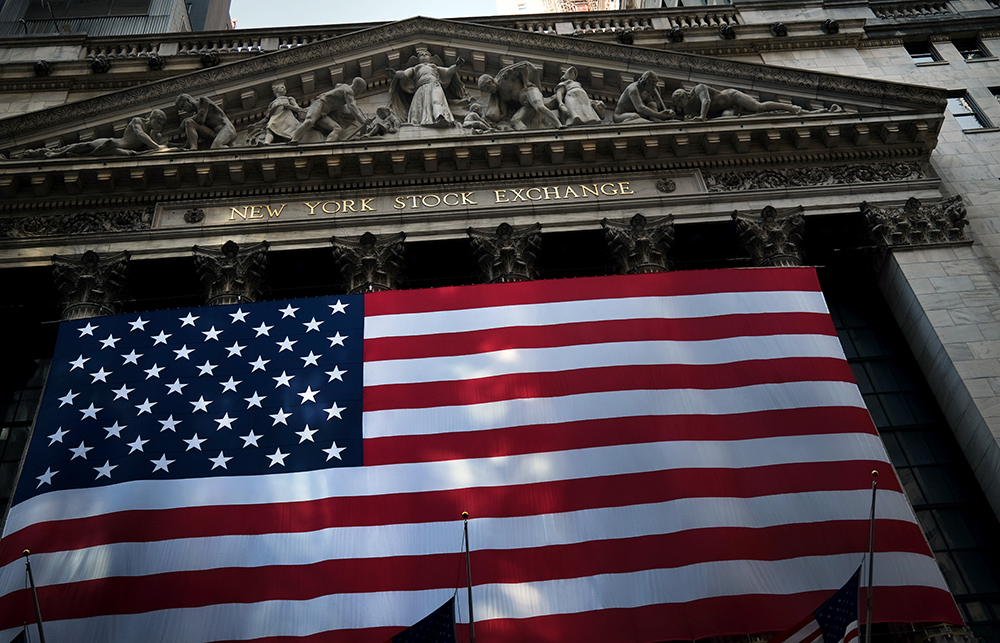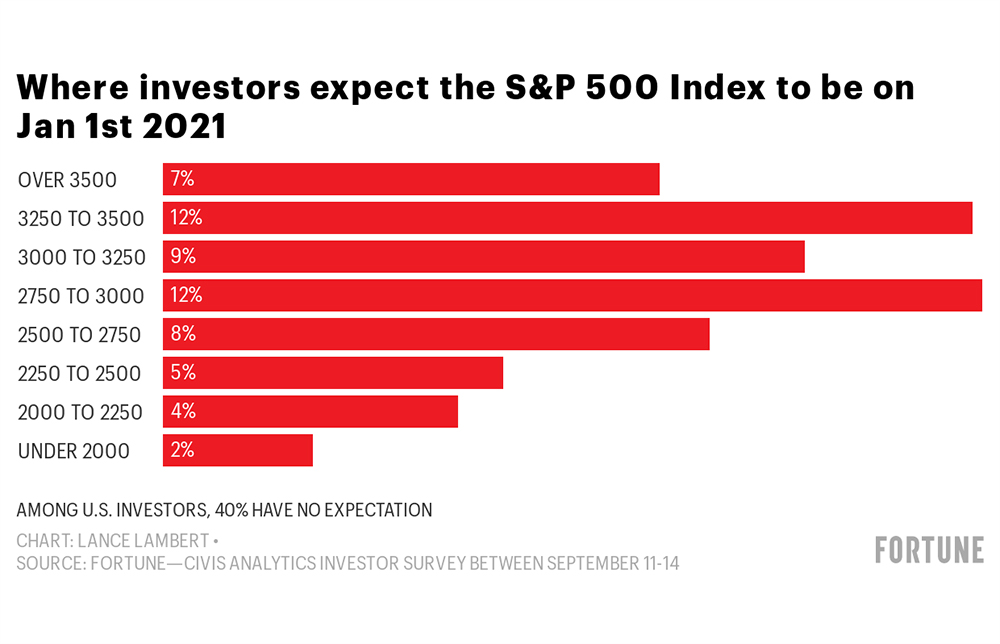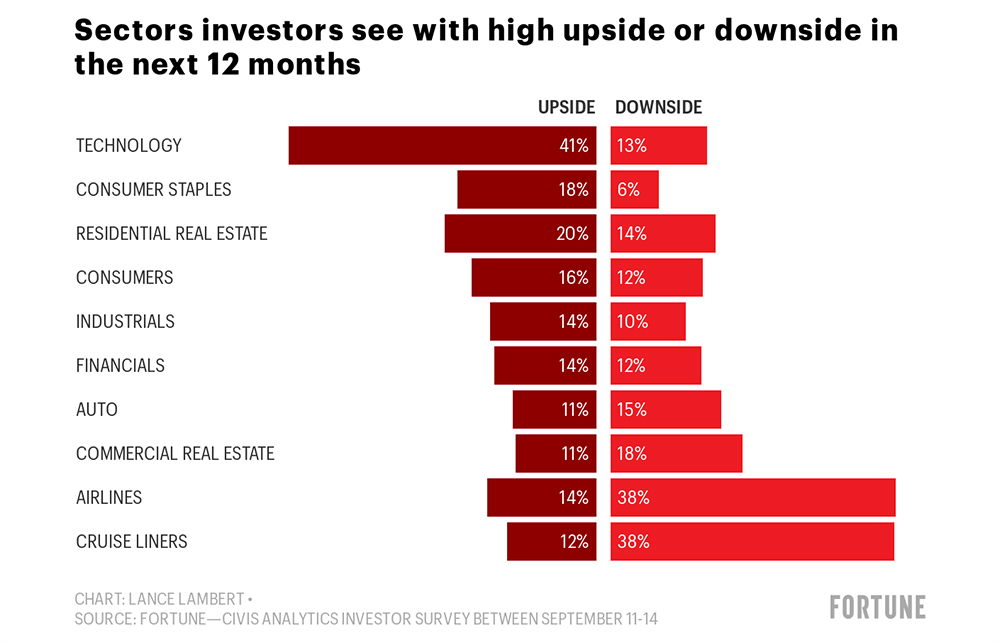
今年3月下旬,在《新冠疫情援助,救濟和經濟安全法案》(CARES Act)通過后,盡管美國的經濟遭受重創,大幅衰退,但股市卻呈現出一片欣欣向榮的利好趨勢。然而好景不長:標準普爾500指數自9月2日飆升至最高點3580點以來,已經下跌近10%。
在春夏兩季取得巨大收益之后,股市的這種下跌僅僅是暫時的挫折,還是更大回落的開始?投資者們還能夠在哪些股票中發現上漲的空間?他們又在回避哪些股票?
為了解答這一問題,《財富》雜志聯手分析機構Civis Analytics,在9月11日至14日期間,共同對1180名美國投資者進行了調查。*在上一次(3月23日這一周)進行的投資者調查中,我們發現,那時的投資者們正在計劃“抄底”,趁股價跌入低谷時購進。然后,標準普爾500指數就攀升了47%。
而目前看來,投資者正在越來越傾向于做空頭。只有28%的投資者認為,標準普爾500指數今年能夠收于3000點以上,而認為該指數今年可以超過3500點的僅有7%。同時,有61%的人擔心,股價有些飚得過高了。

9月的回落對科技股而言是殘酷的。本月,納斯達克下跌了11%,蘋果和特斯拉的股價均下跌了20%。
盡管如此,投資者仍然認為,在未來的12個月中,漲幅最大的還將是科技股——3月,就在這些股票飆升之前(當時亞馬遜的股價為每股1940美元,然后漲到3000美元以上),他們也是這么說的。

哪些股票是他們不會觸碰的?那些有賴于回歸疫情前常態的企業。投資者認為,航空公司和郵輪公司的股價仍然會持續低迷,處于谷底地位——看跌這些公司股票的人數是看漲的兩倍。而在3月,他們也同樣是這么認為的。
他們的看法很容易理解:由于疫情將繼續阻礙商務和休閑旅行,航空公司仍然在以每天數百萬美元的速度虧損。(財富中文網)
*調研方法:《財富》雜志和Civis Analytics公司在9月11日至14日期間,對1180名美國投資者進行了調查。調查對象必須通過股票或債券等金融資產的形式進行過交易。
編譯:陳聰聰
今年3月下旬,在《新冠疫情援助,救濟和經濟安全法案》(CARES Act)通過后,盡管美國的經濟遭受重創,大幅衰退,但股市卻呈現出一片欣欣向榮的利好趨勢。然而好景不長:標準普爾500指數自9月2日飆升至最高點3580點以來,已經下跌近10%。
在春夏兩季取得巨大收益之后,股市的這種下跌僅僅是暫時的挫折,還是更大回落的開始?投資者們還能夠在哪些股票中發現上漲的空間?他們又在回避哪些股票?
為了解答這一問題,《財富》雜志聯手分析機構Civis Analytics,在9月11日至14日期間,共同對1180名美國投資者進行了調查。*在上一次(3月23日這一周)進行的投資者調查中,我們發現,那時的投資者們正在計劃“抄底”,趁股價跌入低谷時購進。然后,標準普爾500指數就攀升了47%。
而目前看來,投資者正在越來越傾向于做空頭。只有28%的投資者認為,標準普爾500指數今年能夠收于3000點以上,而認為該指數今年可以超過3500點的僅有7%。同時,有61%的人擔心,股價有些飚得過高了。
9月的回落對科技股而言是殘酷的。本月,納斯達克下跌了11%,蘋果和特斯拉的股價均下跌了20%。
盡管如此,投資者仍然認為,在未來的12個月中,漲幅最大的還將是科技股——3月,就在這些股票飆升之前(當時亞馬遜的股價為每股1940美元,然后漲到3000美元以上),他們也是這么說的。
哪些股票是他們不會觸碰的?那些有賴于回歸疫情前常態的企業。投資者認為,航空公司和郵輪公司的股價仍然會持續低迷,處于谷底地位——看跌這些公司股票的人數是看漲的兩倍。而在3月,他們也同樣是這么認為的。
他們的看法很容易理解:由于疫情將繼續阻礙商務和休閑旅行,航空公司仍然在以每天數百萬美元的速度虧損。(財富中文網)
*調研方法:《財富》雜志和Civis Analytics公司在9月11日至14日期間,對1180名美國投資者進行了調查。調查對象必須通過股票或債券等金融資產的形式進行過交易。
編譯:陳聰聰
After the late March passage of the CARES Act, stocks went on a tear even as the economy plummeted. But that run is over: The S&P 500 Index has declined nearly 10% since its peak at 3,580 points on Sept. 2.
Is this just a temporary setback, after a spring and summer of huge gains, or the start of a bigger pullback? Where can investors still find upside—and what stocks are they avoiding?
To find out, Fortune and Civis Analytics joined up to survey 1,180 U.S. investors between Sept. 11 and 14.* When we last surveyed investors, the week of March 23, we found that they were planning to buy the dip. Then the S&P 500 climbed 47%.
Now it looks like investors are getting more bearish. Only 28% of investors see the S&P 500 finishing the year above 3,000 points, and a meager 7% see it over 3,500 points. Meanwhile, 61% are worried stocks are overpriced.
The September pullback has been brutal for tech stocks. This month, the Nasdaq has fallen -11%, and both Apple and Tesla shares are down 20%.
Nevertheless, investors still see tech stocks as having the most upside in the coming 12 months. They told us the same back in March, right before those stocks soared (Amazon was $1,940 per share at the time; then it went up to over $3,000).
What stocks aren't they touching? Those of businesses that rely on things returning to a pre-COVID normal. By a 2 to 1 ratio, investors see airlines and cruise lines to have the most downside—still. In March, they felt the same.
It's easy to see their perspective: Airlines are still losing millions per day as the pandemic continues to hamper business and leisure travel.
*Methodology: The Fortune–Civis Analytics poll was conducted among 1,180 investors in the U.S. between Sept. 11 and 14. Investors must trade financial assets like stocks or bonds.






